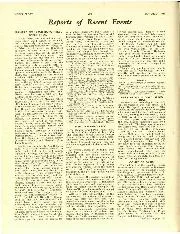
Reports of Recent Events, September 1947
Hants & Berks M.C. Burghfield Speed Trial In these days one must not scorn any place where speed events can be held, and consequently the warmest praise is due to…
John Surtees won the inaugural Can-Am title in one without a roof in 1966, and Penske Racing claimed victory in the Daytona 24 Hours fielding one with a roof three years later. These notable successes largely bookend the front-line racing career of the Lola T70 in all its incarnations spanning the second half of the 1960s.
Lola’s T70, both in spyder and coupé form, was a stalwart of the sports car scene, both internationally and on the domestic front, in that period and a little bit beyond. Approaching 100 of the things were built for a range of classes, starting out with the Group 7 division that spawned Can-Am in North America, then Group 6 on the European and world stages and finally for the Group 4 GT category.
The T70 was born of Lola’s involvement in the Ford GT40 project and a growing appetite for big-banger sports cars on both sides of the Pond. Lola founder Eric Broadley incorporated the lessons learned developing the first iteration of the Ford GT into a new monocoque design for the 1965 season. A works development team was established together with Surtees, which honed the car with first a domestic campaign and then graduating to North America before going on to win the title — and three of the six races — in the inaugural Canadian-American Challenge the following season with a Chevrolet-engined spyder MkII.

The first coupé arrived in 1967 with the third evolution of the T70. Surtees took a pair of MkIII Group 6 racers to Le Mans with Aston Martin power. The project was an inglorious failure, both cars retiring with engine issues inside the first 25 laps. But the big Lola continued to rack up the successes in shorter races on the home front, with the likes of Brian Redman, Frank Gardner and Sid Taylor driving.
When the sport’s governing body, the Commission Sportive Internationale, re-landscaped its sports car racing classes, the T70 became a GT car in 1968. The rules demanded a minimum production run of 25 cars, but no road homologation, so the ubiquitous Lola made the cut. The result was the MkIIIB GT, which like another version of the open-top T70 was pretty much an all-new car. The tub was upgraded and the suspension was shared with the Formula 5000 T142.
It was the closed version of this car that claimed the T70’s biggest victory, or perhaps more accurately, its most famous. The Penske-run MkIIIB shared by Mark Donohue and Chuck Parsons outlasted the opposition at the Daytona International Speedway to take a victory that the great team is still trying to emulate to this day.
Lola Heritage records that 89 T70s rolled out of the famous Slough factory prior to the end of 1969, the Mk2 spyder being the most numerous with 33 built. There have three distinct runs of continuation cars since. Lola built five cars in the 1980s as historic racing began to boom and then, under the stewardship of company saviour Martin Birrane, a similar-sized run of MIIIBs was constructed circa 2007. Broadley Automotive, established by Lola expert Chris Fox with the backing of Eric’s son Andrew, today offers MkII spyders and MkIII coupés built to the original drawings.

The T70 in all its forms has found multiple homes on the historic racing scene. The big Lolas are a common sight in the FIA Masters Historic Sports Car Race Series, Peter Auto’s Classic Endurance Racing 1 championship and the Historic Racing Sports Car Club’s Guards Trophy.
Continuation cars sell for somewhere between £300,000 and £400,000. Period cars with provenance should go for double that, while machinery with unequivocal and continuous histories will easily run well into seven figures.
• Price new n/a
• Price now £300,000 to £1.5 million
• Engine 4.5/4.7/5.0/5.5/5.9-litre Chevrolet V8, 4.6-litre Ford V8, Aston Martin 5.0-litre V8, etc
• Rivals McLaren M1B & M6B, Chaparral 2E, Ford MkIV, Porsche 917
• Verdict A success on multiple fronts